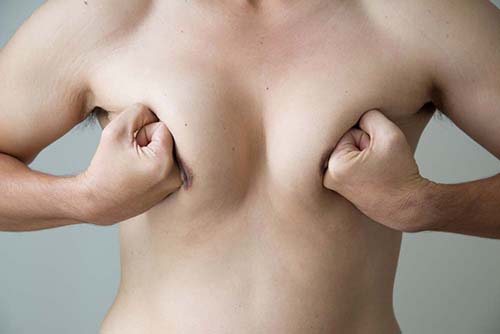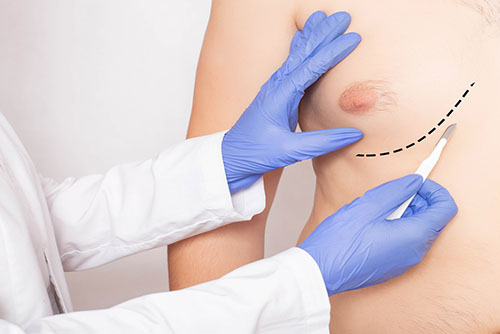Gynecomastia Surgery In Turkey - Symptoms, Diagnosis and Treatment

- What is Gynecomastia?
- What Causes Gynecomastia?
- What are the Complications that May Occur with Gynecomastia?
- How to Prevent Gynecomastia?
- What are the Symptoms of Gynecomastia?
- How Is Gynecomastia Diagnosed?
- Types of Gynecomastia
- How Is Gynecomastia Treated?
- Gynecomastia Surgery Turkey
- Lifestyle Changes and Home Care for Gynecomastia
Gynecomastia is defined as benign, excessive breast development in men. It is derived from the Greek words gynec (feminine, feminine) and mastos (breast). Some studies say that one out of every 3 men has gynecomastia. Gynecomastia, which can also be observed in infancy and old age, occurs most frequently in adolescence. According to a study conducted in UK country, the prevalence of the disease in adolescent boys is 34.6%. Although gynecomastia is not harmful to health, it causes distress and embarrassment to the person himself. Long-standing gynecomastia cannot regress spontaneously. It requires medical treatment and, if necessary, surgical intervention.
What is Gynecomastia?
Gynecomastia is the name given to abnormal but benign growth in the amount of breast tissue in men due to an imbalance of estrogen and testosterone hormones. Gynecomastia may affect one breast in some cases and both breasts in some cases. Both breasts may be affected irregularly and reach different sizes.Newborns, teenage boys, and older men can develop gynecomastia as a result of normal changes in hormone levels. However, there are other reasons for the development of gynecomastia.
Gynecomastia is not a serious problem in many cases, but coping with this condition can be difficult for individuals. It has been observed that men with gynecomastia feel pain in their breasts. In some cases, it can be seen that the individual feels ashamed of the situation.
Depending on the cause of gynecomastia, it may heal spontaneously in some patients, and in some patients, drug treatment or surgery may be required to solve the problem.

What Causes Gynecomastia?
Gynecomastia is often caused by fluctuations in the level of the hormone testosterone. The decrease in the amount of testosterone hormone can be caused by conditions that block the effects of testosterone in the individual, reduce testosterone or increase estrogen levels. Hormone balance in the body can be disturbed for many different reasons. Causes of gynecomastia include natural hormonal changes, drug use, drug and alcohol use, complications from various health conditions, and the use of certain herbal products and supplements. The hormones testosterone and estrogen control sex characteristics in both men and women. Testosterone controls masculine traits such as muscle mass and body hair, while estrogen controls feminine traits, including the growth of breasts. Even though estrogen is defined as a female hormone, it produces very small amounts in men under normal conditions. Too much estrogen production above normal, or an unbalanced estrogen production with testosterone level can cause gynecomastia.Male babies can be born with enlarged breasts due to the effect of estrogen in their mother's body before birth. This swollen breast tissue disappears within two to three weeks after birth in most cases. The possibility of gynecomastia is relatively common during adolescence due to constantly changing hormone levels. In most cases of gynecomastia seen in adolescence, swollen breast tissue disappears without treatment. The prevalence of gynecomastia in adults starts to rise again between the ages of 50-69. Studies indicate that at least one out of every four men in this age group shows signs of gynecomastia.
Some types of drugs can cause gynecomastia. These drugs primarily include anti-androgens, which are used to treat enlarged prostate, prostate cancer, and other similar conditions. Anabolic steroids and androgens prescribed by doctors for certain conditions or sometimes illegally used by athletes to increase muscle mass or improve performance in competition can also cause gynecomastia. There are publications reporting that some antidepressants and heart medications also cause gynecomastia. In addition to amphetamines, which are normally used to treat attention deficit or hyperactivity disorder, drugs such as heroin, cannabis, and excessive alcohol production can also cause gynecomastia.
Some health problems can cause gynecomastia by affecting the body's normal hormone balance. For example, conditions that affect normal testosterone production and lead to hypogonadism, such as Klinefelter syndrome or pituitary insufficiency, may be associated with gynecomastia. Hormonal changes that occur with normal aging can also cause gynecomastia, especially in overweight men. Some tumors that affect the testicles, adrenal glands, or pituitary gland can affect hormone production, altering the male-female hormone balance and causing gynecomastia. About half of individuals undergoing dialysis treatment for kidney failure may develop gynecomastia due to hormonal changes. Various liver problems and cirrhosis medications can cause gynecomastia by causing changes in hormone levels.
Malnutrition and starvation can cause gynecomastia because when the human body is deprived of adequate nutrition, testosterone levels drop while estrogen levels stay the same. This causes hormonal imbalance. Even if gynecomastia does not start during this period, it can also occur when normal nutrition starts again.

What are the Complications that May Occur with Gynecomastia?
The physical complications of gynecomastia are limited in number, but it can cause psychological or emotional problems in the individual arising from the external appearance.
How to Prevent Gynecomastia?
There are several factors that individuals can control to reduce their risk of gynecomastia. Avoiding alcohol consumption is recommended. Unintended use of drugs should be avoided without physician control.
What are the Symptoms of Gynecomastia?
Signs and symptoms of gynecomastia primarily include swollen breast tissue and sometimes breast tenderness. In case of swelling, pain, or tenderness in the breast, or nipple discharge in one or both breasts, the individual should consult a doctor as soon as possible.
How Is Gynecomastia Diagnosed?
In order to diagnose gynecomastia, the doctor first performs a physical examination and aims to learn information about the health history of both the patient and his family with various questions to ask. The patient should discuss all the symptoms they observe with the doctor during this examination and share information about other conditions or diseases they may have.During the physical examination, the doctor will evaluate the breast tissue and perform other controls. In cases where gynecomastia is diagnosed, the doctor may consider it appropriate to perform blood tests to determine the cause of the condition. Depending on these initial test results, further tests such as computed tomography scans, magnetic resonance imaging scans, testicular ultrasound and tissue biopsy may be needed.
There are several other conditions with signs and symptoms similar to breast swelling seen during the gynecomastia process. The first of these is excessively fatty breast tissue. Some men have a layer of breast fat that looks like gynecomastia. This is not the same condition as gynecomastia and does not need additional evaluation.
Breast cancer is rare in men. In cases where only one breast is enlarged or there is a hard nodule in the breast, the possibility of male breast cancer should be considered.
A breast abscess, which is an infection of the breast tissue, can also lead to enlargement of the breast.
Types of Gynecomastia

There are different types of gynecomastia problems that patients experience. There are different types, from very mild cases to very intense and sagging cases.
- 1st degree gynecomastia: We can also call it the first stage. Breast size remains limited, skin laxity or sagging is not experienced. Here, it will be sufficient to remove the adipose tissue with liposuction.
- 2nd degree gynecomastia: In the second stage, there is a large female breast appearance, but the skin does not sag.
- 3rd degree gynecomastia: In the third stage, fat removal alone is not enough. In addition, there is a degree of laxity in the skin that can be eliminated with surgical treatment.
- 4th degree gynecomastia: Breasts are like female breasts. It is large and sagging is advanced.
How Is Gynecomastia Treated?
If gynecomastia does not improve on its own or if it causes serious pain, sensitivity or psychological problems that affect the individual's quality of life, treatment may be required. Treatments may be in the form of medication or surgical intervention.There are two different surgical intervention approaches commonly used for gynecomastia.
In liposuction, the surgeon removes only the breast fat, but leaves the mammary gland tissue behind.
In mastectomy type surgical interventions, the mammary gland tissue is completely removed by the surgeon. This surgery is usually done using only small incisions.
Most cases of gynecomastia get better on their own over time without the need for treatment. However, if gynecomastia is caused by an underlying condition such as hypogonadism, malnutrition, or cirrhosis, the underlying condition may need to be treated.
The doctor may recommend that individuals stop taking drugs or prescribe another drug for drugs that can cause gynecomastia.
In cases that occur during puberty and have no obvious cause of gynecomastia other than normal hormone changes, the doctor may recommend periodic reassessments every three to six months to see if the condition improves on its own. In this case, gynecomastia, which is seen in many cases, usually heals spontaneously in less than two years without treatment.
Gynecomastia Surgery Turkey

Surgical intervention is the most effective and definitive method in the treatment of gynecomastia. The type of intervention is decided after the examinations made by the surgeon. Again, different methods can be used against different classifications of gynecomastia. For example;
- In glandular type gynecomastia, hard breast tissue is predominant and needs to be surgically removed.
- There is excess glandular tissue and adipose tissue in mixed type gynecomastia, surgery and liposuction are used together.
- Fatty type gynecomastia is predominantly fat tissue, it can only be treated with liposuction.
Grade 1 Gynecomastia, local anesthesia is applied for these milder cases where fat tissue is removed by liposuction. If the mammary gland is also to be reduced, general anesthesia is applied for the comfort of the patient and for the surgeon to work comfortably. Gynecomastia surgery may take 2-3 hours.
In first degree gynecomastia surgery, liposuction is performed by entering the cannula from the patient's armpit. In patients with second degree gynecomastia, liposuction is also applied. Surgical removal of the mammary gland is not required during surgery if it is okay that there is sufficient reduction in the tissue under the nipple after liposuction is complete. The chest corset used in these patients. If the mammary gland under the nipple is still prominent after liposuction, the mammary gland is also reduced by entering through a crescent-shaped incision made under the nipple.
In third-degree and fourth-degree gynecomastia, liposuction and mammary gland removal are performed together. If the patient is young and there is no advanced growth, there is a high chance that the sagging skin will recover. It is much more difficult for the skin to heal at advanced ages. In advanced cases, the skin should be corrected with a technique similar to breast reduction surgery, just like the mammary gland.
In cases where the mammary gland needs to be surgically reduced, a drain is placed in the area. The purpose of the drain is to discharge fluids such as blood that may accumulate under the skin in the operation area. The drain is usually removed within 24-48 hours.

How Long Does Gynecomastia Surgery Take?
The duration of the operation takes 2-3 hours depending on the technique to be applied.
After Gynecomastia Surgery in Turkey
The healing period experienced after gynecomastia surgery differs according to the technique of the surgery. If vaser or laser liposuction techniques are preferred in the treatment, the healing process is very comfortable. In the formation of gynecomastia due to adipose tissue, after vaser and laser liposuction applications, the person gets effective results at the end of about 3 weeks and can easily do many activities.In cases requiring surgical intervention, although the operation is usually performed under general anesthesia, local anesthesia may also be preferred in some cases. The person can be discharged on the same day after the operation. Depending on general anesthesia, the person may need to be kept under observation overnight, but this is not very common.
It is normal to see edema and swelling in the area after gynecomastia surgery. These formations go away on their own within the first week. There may be mild muscle pains after the operation. Resting for 3 days after gynecomastia surgery and not moving the arms and shoulders too much is important for the comfort and healing process of the person. On the 3rd day of the operation, you can take a shower, go back to work, and take light walks.
Gynecomastia Corset
Gynecomastia corset is a medical product that should be used after gynecomastia surgeries. One of the most important points after gynecomastia surgery is the constant use of this corset. This corset, which is very simple to use, should be worn immediately after the operation and should be worn continuously for a period determined by your doctor (2-3 weeks). After the third week, it is beneficial to wear the corset only during the daytime, especially during heavy activities. This period is about 6 weeks.
Lifestyle Changes and Home Care for Gynecomastia
The anatomical appearance caused by an enlarged breast can be a stressful and embarrassing situation for some men. Gynecomastia that develops during adolescence can make boys the target of unfair taunts from their peers. Activities such as locker room, swimming, and dressing after sports can become traumatic for the individual.Regardless of age, the individual may feel bad. The individual can take various steps to cope with this situation and emotions.
In case of gynecomastia, seeking professional counseling will help the individual. Cognitive talk therapy can both help avoid the anxiety and depression caused by gynecomastia and help the individual communicate with their spouse or other family members in a way that expresses what they are going through or feeling.
There are no comments yet. Would you like to add a comment?
In accordance with Article 10 of the Personal Data Protection Law (PDPL,KVKK) titled Data Controller's Obligation to Disclose, we use cookies in accordance with the legislation, limited to the purposes specified in the privacy policy.

